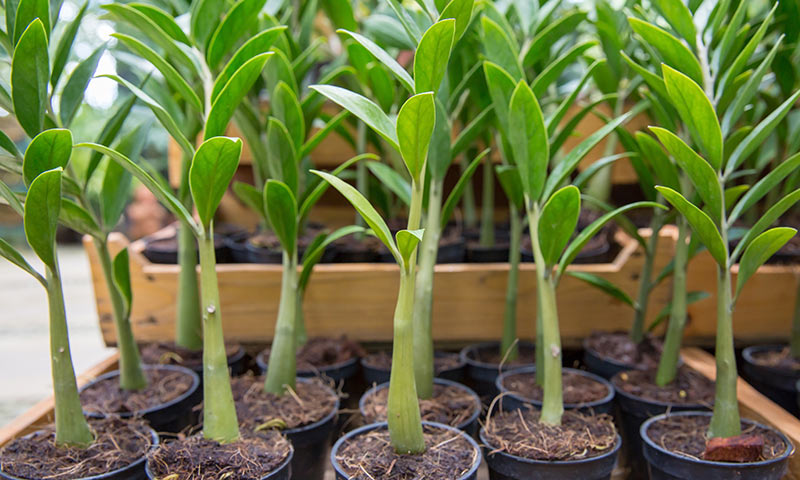How to Grow and Care for ZZ Plants
Do an internet search for "plants you can't kill," and you'll find ZZ plants on many lists. Though ZZ plants aren't really indestructible, these resilient, easy-care plants can make almost anyone look like an experienced green thumb. By learning how to grow and care for ZZ plants, you can enjoy their exotic appeal — and impress your friends and family.

Fleshy, water-storing rhizomes and stems help ZZ plants endure drought.
Understanding ZZ Plant Basics
ZZ plant takes its name from its botanical handle: Zamioculcas zamiifolia. Native to tropical East Africa, this low-maintenance plant is also known as Zanzibar gem or the aroid palm. It belongs to the same plant family as the peace lily, another undemanding plant. But unlike peace lilies, ZZ plants rarely flower indoors. When they do, the inconspicuous bloom resembles the start of a peace lily flower.
In their native habitat, ZZ plants grow from drought-prone grasslands to dry forests. They spread via underground stems called rhizomes. The plump rhizomes look a lot like potatoes, but they play a special role. Like other succulent plants, ZZ plants store water in their rhizomes and fleshy stems — a handy feature in times of drought. Though slow-growing, common ZZ plants reach 2 to 4 feet tall and wide.
ZZ plant leaves grow from the rhizome at soil line, so each "stem" lined with waxy green leaflets comprises a single leaf. New growth is lighter and brighter than existing leaves, creating a two-toned effect. As ZZ plants grow in popularity, so do available options. Choices range from bright green to dark, green-black leaflets paired with lime-green new growth and long, arching, leaflet-lined stems.

ZZ plant flowers are small, inconspicuous blooms similar to peace lily flowers.
Caring for ZZ Plants
The key to growing ZZ plants is to supply the basics and let the plant flourish with minimal fuss. It does quite well under conditions typically found in most homes.
- Light – ZZ plants tolerate low light conditions, but don't believe stories that say they can live with no light at all. A north-facing or east-facing window with indirect or filtered light is ideal for ZZ plants. Avoid harsh, direct sunlight, which can scorch ZZ leaves and leave scald marks.
- Soil – Well-draining soil and good aeration are critical for ZZ plant's rhizomes and roots. A commercial potting mix for indoor plants or a potting mix designed for succulents provides good drainage that suits ZZ plants well.
- Water – Depending on your home's conditions, ZZ plants can go weeks between waterings. Always check the soil before you water, and water when the soil is dry about 3 inches down. In spring and summer, watering twice a month is normal — as long as the soil is dry. ZZ plants rest in winter, so cut watering back to once a month then.
- Fertilizer – ZZ plants benefit from a good foundation of essential plant nutrients at planting time and every spring. Just one application of Pennington Rejuvenate Plant Food All Purpose 4-4-4 starts feeding your plant immediately, then it keeps feeding for up to four months. Extra nitrogen from OMRI-listed Alaska Fish Fertilizer 5-1-1 helps support lush, green growth. Pause fertilizers during winter months.
- Pruning – ZZ plants don't require regular pruning. Remove dead or damaged leaves or leaflets anytime. ZZ plant sap can cause skin reactions, so consider wearing gloves if you prune or trim.
- Propagating – As with peace lilies, division is the simplest way to propagate ZZ plants. Remove the plant from its pot and gently pull the rhizomes apart — they'll separate easily. Then repot the rhizomes, with "stems" and leaflets attached, at the same depth they were growing at before. You can also start new ZZ plants from single leaflets with the help of GardenTech RootBoost Rooting Hormone, similar to propagating succulents from leaves.
- Repotting – Because ZZ plants grow slowly and don't get too large, they don't outgrow pots often. If you're dividing your plant, you can repot with fresh potting mix in the same container. Otherwise, choose a container with unobstructed drainage holes that's just a few inches larger than the existing pot. To reduce transplant shock, use Pennington Plant Starter at repotting time.

Beware of curious pets and kids: All parts of ZZ plants are toxic if eaten.
Troubleshooting ZZ Plant Problems
ZZ plants have very few problems under proper care and conditions. Most troubles start with overwatering. Soft, weak, droopy leaves point to overly wet soil. Leaves of overwatered plants may turn yellow, then brown or black. At this stage, rhizome and root rot also occurs.
If your ZZ plant starts to falter, check the soil moisture. If necessary, carefully remove the plant from the pot. Discard any rhizomes that are soft or rotted. Then repot firm, healthy rhizomes in fresh potting mix and get back on track.
All parts of ZZ plants are toxic to humans, dogs and cats if eaten. Some people also report allergic reactions from touching ZZ plants or their sap. Teach pets and children to direct their curiosity elsewhere and avoid handling ZZs and other houseplants.
By learning how to grow and care for ZZ plants, you can enjoy their low-maintenance beauty and help win new fans to gardening. Baby ZZ plants make excellent gifts and almost guarantee success — even for brand-new gardeners. At Pennington, we're here to help you every step of the way to beautiful houseplants and productive gardens.
Always read product labels thoroughly and follow instructions.
Source:
1. North Carolina Extension Gardener Plant Toolbox, "Zamioculcas Zamiifolia," NC State Extension.





